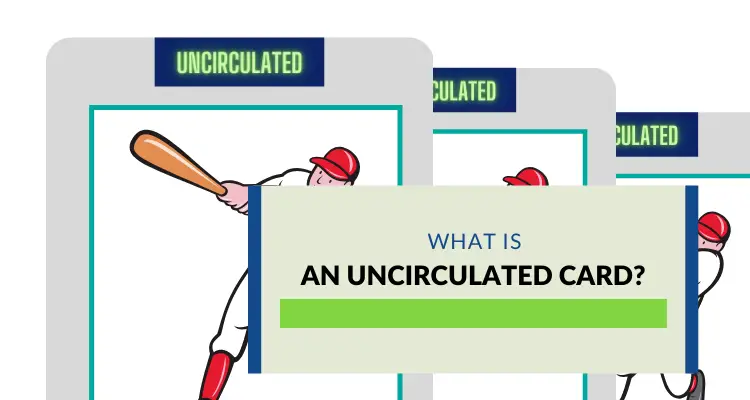 Ryan Barone (@ballcardgenius on TikTok, Card Expert) is a lifelong member of the hobby. He has been quoted in PSA Magazine, and his content has regularly been mentioned in “Quick Rips” (the Topps RIPPED Newsletter) and across other hobby publications. Join his 8,600 followers on TikTok! hello@ballcardgenius.com; Last Time Ago LLC dba Ballcard Genius.
Ryan Barone (@ballcardgenius on TikTok, Card Expert) is a lifelong member of the hobby. He has been quoted in PSA Magazine, and his content has regularly been mentioned in “Quick Rips” (the Topps RIPPED Newsletter) and across other hobby publications. Join his 8,600 followers on TikTok! hello@ballcardgenius.com; Last Time Ago LLC dba Ballcard Genius.
Affiliate Disclosure: This post contains affiliate links. As I am a part of the eBay Partner Network and other programs, if you follow these links and make a purchase, I’ll receive commission. As an Amazon Associate, I earn from qualifying purchases.
GS (or sometimes G&S) stands for “Goods and Services” and refers to payment, specifically, PayPal payment. Meaning, if you pay for something via PayPal, you’re given the option to pay “Goods and Services” or “Friends and Family.” With GS, you’re eligible with PayPal purchase protection, however, you don’t have that same coverage when “paying someone you know” with the Friends and Family” option.
Bonus: Personally, I’d pay GS for any PayPal card purchase. First of all, that’s what PayPal intends for such transactions, and as mentioned, you receive the potential protection just in case something goes wrong.
Here are a few other trading card abbreviations you should know:
FF
FF (or sometimes F&F) stands for “Friends and Family” and again, refers to payments made through PayPal. As explained above, sending money via Friends and Family makes the purchase ineligible for PayPal protection.
FS/NFS
FS stands for “for sale” and NFS stands for “not for sale.” While you might think it is obvious when someone is posting a card for sale given they’re also including a price and shipping options, most likely, the mention of “FS” is usually a more blatant way of saying “I’d like to sell and not trade,” for the most part.
In terms of when NFS is used, you’ll often see hobby members posting great cards they pulled from packs or bought as a single on the many different places to buy baseball cards. When doing this, it’s common for others to ask if the card they are posting is “for sale,” so by including “NFS” in their posts, they can help answer the question before it needs to be asked.
FT/NFT
FT stands for “for trade” and NFT stands for “not for trade.” The hobby isn’t always about buying and selling, and can in fact include trading baseball cards.
So, similar to the above, posters will include “FT” if they’re looking to trade, but you’ll often see it accompanied with the above, as in “FS/FT” meaning that the poster is open to both selling and trading. The same goes for “NFT” where you’ll usually see it as “NFS/NFT.”
Bonus: “NFT” has now taken on a much bigger and different meaning as of late, and can be known as “non-fungible token.” I won’t be getting into that type of NFT here, and while there is a little bit of an overlap between NFTs and cards, it’s beyond the scope of this post.
OBO
OBO stands for “or best offer,” and is used when a card is put up for sale with a particular price. For instance, you might see something like “$100 shipped obo” and all that really means is, the card can be purchased for $100, or, if not, the seller will consider the best offer stated by interested buyers. Even in the absence of “OBO” a seller might be willing to negotiate on their stated price. That said, if the seller includes “firm” then that means it’s the stated price or nothing.
PWE & BMWT
I won’t spend too much time here since I’ve already covered the topic, but it needs to be mentioned given it’s a big piece of any transaction.
When purchasing cards, PWE stands for “plain white envelope” and is exactly what it sounds like—your card will be sent in a white envelope that doesn’t have padding or tracking (usually) and is thus to be considered less safe than other options. As such, it’s typically a shipping option reserved for lower-value cards.
On the other hand, BMWT stands for “bubble mailer with tracking” meaning your card(s) will be sent in a padded bubble mailer, and with USPS tracking so that you can follow the purchase along its journey from seller to you.
Read More: How to Ship “PWE” with eBay Standard Shipping
Now, eBay has currently rolled out a new “PWE” shipping option that does in fact include tracking, but when purchasing on social media and similar platforms, tracking with PWE isn’t typically an option.
DLVD
When you see “DLVD” it’s usually when someone is selling a card and wants it known that the price they are selling for is the total price “delivered” to you. So, if I have this card for $50 DLVD, it means you’ll pay $50 total to purchase, and not $50 plus shipping.
Card Buying & Selling Resources
I’m hoping the above definitions help make your card buying, selling, and trading endeavors a bit easier. Still a bit confused on certain terms? Feel free to add them to the comments.
Where to buy cards
Baseball card values apps
How to organize baseball cards
Baseball card subscription boxes
What is a blaster box?
Hobby box vs. retail



